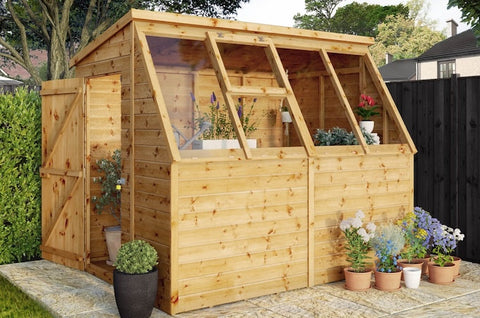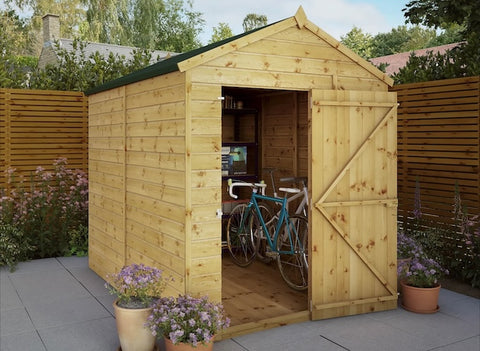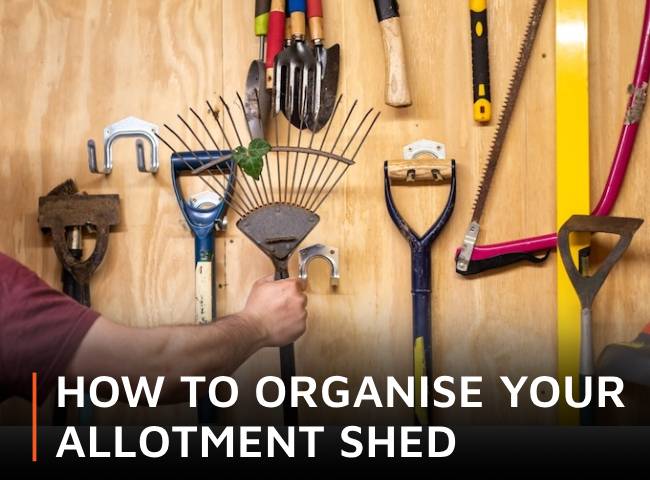Anyone leaving tools or equipment at their allotment will need a shed to keep everything secure. It’s a big investment, so you’ll want to make the most of it. To help you do that, we asked some of our favourite allotment bloggers, YouTubers and Instagrammers for their top tips on organising and using an allotment shed. Here’s what they said.
In the meantime, if you’re setting up a new plot, browse our full range of wooden sheds for inspiration.
What advice would you give to someone buying their first allotment shed?

Image: 8 x 6ft Shiplap Potting Shed Wooden Greenhouse from Waltons
Before you buy a shed, do your homework and don’t rush. That’s the sage advice from Greg Holton at @greggrowsuk. He says, “take some time on your plot to work out where would be an ideal location and what size you might need, and ask neighbours what has worked well for them!”
It’s important to take the lie of the land into account – you’ll need a level site for your shed, and if you intend to use it for potting, its orientation to the sun will be important. Also check your proposed site’s proximity to hedges and walls – you need a reasonable gap to allow for air circulation and routine shed maintenance.
Once you’ve decided on the size and location for your shed, Woody at Cumbrian Homestead suggests investing in the best-quality building you can afford. His recommendation is to make sure you “anchor it securely and place it on blocks above the soil level to avoid rotting the lower timbers.” With good maintenance, Woody goes on to say, your shed will last many years and prove to be a great investment.
When choosing a shed, try to imagine how you will use the space. Substack writer Sally Nex says that hers isn’t just for storing the obvious tools – she also uses her shed to store consumables like peat-free compost “which needs to be kept dry otherwise, it deteriorates.” And Greg Holton reminds us to allow for the fact that your needs may evolve over time. He thought he’d mainly use his shed for tool storage, but has ended up using it more for shelter!
Kev Alviti from An English Homestead uses his shed for a favourite hobby. His ‘brew shed’ contains “gallons of unusual wines that sit in there until they're ready to bottle, then drink.”
The common thread running through all of this expert advice? If you can afford it, and have the space, opt for a slightly bigger shed than you may think you need right now.
What are your tips for organising an allotment shed?

Image: Shutterstock
A system for organising your shed is always a good idea. Nick Moyle from Two Thirsty Gardeners recommends starting as you mean to go on, because “as soon as one item gets casually thrown in, it’s downhill all the way!”
To help keep your shed tidy, Kev Alviti recommends lots of shelves and hooks. “I like the saying, ‘A place for everything and everything in its place’," he says. Work out what you’ll need to store in advance, and plan dedicated storage solutions for each item.
When it comes to tools, Woody at Cumbrian Homestead suggests hanging them up rather than leaving them in a pile and, if you need to store seeds, source some watertight containers. He also recommends a small basic toolbox “as there are always repair jobs to do,” and says “a small first aid kit is also useful.”
Sally Nex likes to use rustic storage containers in her shed, writing that she gets “old wine crates or apple crates off Facebook marketplace and label[s] them – so there’s one for irrigation gear, one for small garden tools, one for hammers/nails/general repair stuff… and so on.”
Greg Holton adds that there’s nothing worse than turning up to do some gardening on your allotment and being confronted with a pile of dirty, disorganised tools. His tip is to make sure your tools are clean before you put them away, so they’re ready to go and you’ll have no excuse not to tackle the weeding!
Have you devised any ingenious storage solutions for your shed?

Image: Shutterstock
"Many allotment holders are passionate about being eco-friendly,” says Fiona Hawkes from Hawkes At Home. With this in mind, she offers these thrifty, eco-friendly allotment storage solutions:
- Glass jars - Perfect for storing seeds, bulbs and even tea bags.
- Tin cans - Cleaned and with the label removed, tin cans can be used as storage for small items such as scissors, pencils, rulers and pen knives.
- Baskets & boxes - Simple wicker baskets and basic plastic boxes can be used for storing pretty much anything - try looking in local charity shops for a cheaper and more environmentally-friendly alternative to buying new.
Over at @greggrowsuk, Greg Holton repurposes old furniture for use in his allotment shed. Instead of taking an old desk to the tip, he rehomed it in his shed where the drawers are “perfect for sorting seeds, labels and small garden tools.”
Meanwhile, Woody at Cumbrian Homestead has an ingenious use for old tights which are good for making plant ties and “storing all the veg you will be taking home.” His other top tip is to make use of every inch of vertical space by screwing hooks into the roof joists. That’s where he hangs his onions! Kev Alviti is also a fan of ceiling hooks. He uses them to hang baskets in which he dries crops and stores peas and beans during the winter.
If you’re wondering where to keep your canes and other plant supports when not in use, Substacker Sally Nex has a handy solution: “Fix two loops of string or wire from the apex of the roof, one at each end, about 1m apart. Use this cradle for storing plant supports at the end of the season.”
Is it possible to rodent-proof an allotment shed?

Image: 8 x 6ft Shiplap Apex Windowless Wooden Shed from Waltons
When it comes to rodent-proofing, Fiona from Hawkes At Home says it takes a lot of work to fully protect your shed, but there are lots of small measures which will help. Her first suggestion is to avoid leaving any food in your shed or, if you do, make sure it’s stored in a strong, airtight container. The same goes for seeds and bulbs. Fiona says, “glass jars are perfect for this purpose as they can't be gnawed through.”
Woody from Cumbrian Homestead also recommends taking anything edible home with you, pointing out that “a mouse can flatten its skull to squeeze through a 5mm gap”. That said, you could do as Fiona does and try using silicone to seal small gaps. For larger openings, she also recommends wire mesh, adding that “mice especially love to chew, so anything you do to help seal up your shed against rodents needs to be fully chew-proof!"
Over at Workshop Shed, Andy Clark protects his orange power tool cables from gnawing rodents by making metal boxes to store them in. He says if you’re not in a position to make your own, metal biscuit tins are a great alternative. We think that’s a great win-win idea, because you also get to eat the biscuits first!
Keeping your shed clean, tidy and well organised means it’s pleasant to use, keeps your tools dry and secure and gives you a better chance of deterring rodents. Do you have a top tip for organising your allotment shed? Get in touch via social media; we love to hear from you.
Lead image: Shutterstock
|
Contributors list
|



Share:
How to choose the right shed: 5 tips from the experts
How to pick the best shed for your allotment